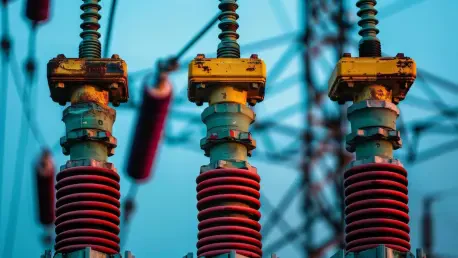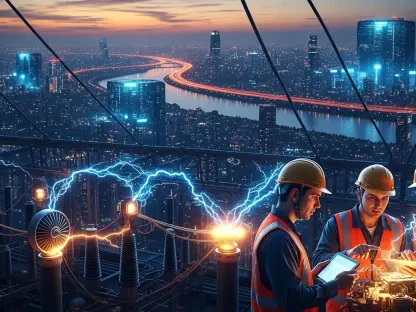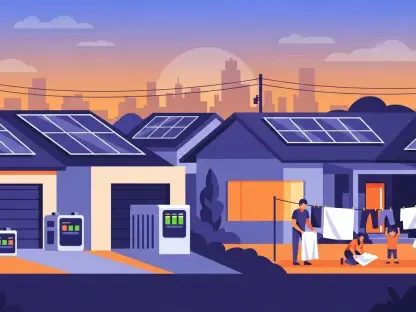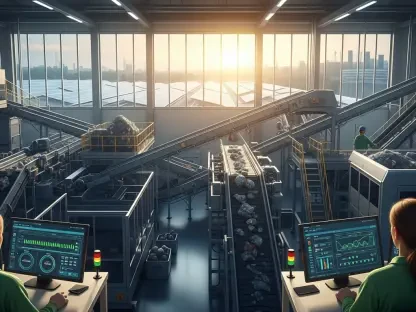The stability and reliability of the United States’ electrical grid have become critical topics of national discourse due to concerns about potential security threats stemming from aging transformers. As the backbone of the national grid, transformers are crucial for maintaining uninterrupted electricity flow, yet many of these components are aging, and their failure could lead to significant power outages. Modern challenges such as increased usage from electric vehicles and high-demand data centers, compounded by external threats like climate disasters and sabotage, highlight the fragile state of the infrastructure. The long lead times for transformer replacement, exacerbated by supply chain disruptions and manufacturing delays, underscore the urgent need for modernizing the grid to enhance national security.
The Fragile State of Aging Electrical Infrastructure
Challenges Posed by Outdated Transformers
The electrical infrastructure in the United States faces threats due to the increasing age of its components, particularly transformers, which are often used beyond their intended lifespan. With many of these transformers installed decades ago, they now face unprecedented demands, leading to wear and potential failure. The grid is further stressed by the rapid adoption of electric vehicles, which impose increased load demands. Additional pressure comes from the integration of renewable energy sources into the grid, requiring more complex energy management strategies. These changes, coupled with the ongoing threats from extreme weather events and potential sabotage, highlight the urgent need to address the vulnerabilities of aging transformers.
The lead times for obtaining replacement transformers have become alarmingly long, now stretching between 80 and 210 weeks, driven by persistent raw material shortages and evolving manufacturing challenges. Tariff implications further complicate this scenario, leaving the power grid at risk of experiencing prolonged outages in the event of transformer failure. A single outage can have widespread implications, disrupting not only basic services but also impacting the economy and national security. Thus, the importance of modernizing grid infrastructure cannot be overstated, given the current limitations and looming challenges.
The Impact of External Threats on Grid Stability
Transformers are increasingly at risk not just from their aging infrastructure and internal grid stresses but also from external threats, including sabotage and climate-related disasters. Incidents such as gunfire attacks on substations in North Carolina and a thwarted attack in Baltimore demonstrate the vulnerabilities of the grid to deliberate acts of vandalism. These events reveal how easily a few critical components can be compromised, causing a cascade of failures across the network. Similarly, natural disasters, such as hurricanes, can wreak havoc on unprotected infrastructure, further illustrating the necessity for bolstered resilience strategies.
The grid’s vulnerability is compounded by the frequency and intensity of these threats. As these destructive events become more common, they expose critical weaknesses in the national power infrastructure. Ensuring that transformers and their monitoring systems are capable of withstanding such adverse conditions requires significant investment in both physical security measures and resilient design. Addressing these issues is crucial to prevent long-lasting damage and secure the electrical grid against an escalating array of threats.
Modernizing Monitoring Methods
Traditional vs. Modern Monitoring Techniques
Historically, transformer monitoring relied on methods like Dissolved Gas Analysis and infrared scanning, which are primarily reactive and only offer insights after damage has occurred. As the risk of transformer failure has grown, these traditional approaches are no longer sufficient for ensuring reliable grid operation. Their limitations underscore the necessity of adopting more advanced, predictive monitoring strategies to safeguard infrastructure in a timely and effective manner. Modern technology offers a valuable alternative by employing AI-driven systems that can predict operational issues and prevent failures before they escalate into widespread outages.
Advanced monitoring systems, incorporated with smart sensors and cloud-based diagnostics, provide continuous evaluation of transformers’ operational health, akin to how a real-time EKG monitors a human heart. These technologies afford utility companies the ability to detect anomalies such as micro-vibrations or thermal changes that serve as early indicators of potential failures. The integration of these sophisticated monitoring tools not only enhances the reliability of the transformers but also enables timely maintenance, effectively preempting unexpected outages and reducing repair costs.
Benefits of Predictive Technologies
Predictive technologies, utilizing AI and advanced analytics, transform transformer maintenance from a reactive task to proactive management. By continuously collecting and analyzing operational data, these systems can forecast potential issues, providing valuable insights that guide timely intervention. This shift towards predictive maintenance strategies has profound implications for extending the lifespan of transformers and improving overall grid reliability. Early detection of faults allows utility operators to address issues promptly, avoiding disruptions and ensuring sustained power delivery.
Moreover, predictive technologies support strategic planning by extending transformers’ operational lifespan and optimizing their performance. They minimize operational costs by allowing maintenance actions to be planned rather than performed as emergency repairs. Additionally, these tools encourage a more sustainable approach to infrastructure management, as they promote efficient use and maintenance of existing resources. This advanced monitoring is a crucial step towards a resilient and secure energy grid, aligned with national security goals and the growing demands of a modernized technological landscape.
Transforming Infrastructure for Greater Resilience
The electrical grid in the United States is increasingly vulnerable due to aging components, particularly transformers, which are being used past their intended life expectancy. Many were installed decades ago and now face heightened demand, causing wear and potential dysfunction. The situation is exacerbated by the swift uptake of electric vehicles, which increase power demands, and the integration of renewable energy sources, necessitating sophisticated energy management. These changes, alongside threats from severe weather events and potential sabotage, underscore the urgent need to address the vulnerabilities of outdated transformers. Replacement transformer lead times have become worryingly extended, ranging from 80 to 210 weeks, due to ongoing raw material shortages and manufacturing setbacks. Tariff issues further complicate this challenge, leaving the grid susceptible to long outages should a transformer fail. Such an outage could disrupt essential services, impacting both the economy and national security. Therefore, it is crucial to modernize the grid to face these impending challenges.









